In the aviation enthusiasm of the 1930s, it was popular to claim that Air Corps bombardiers could drop a bomb into a pickle barrel from high altitude. In 1940, Theodore H. Barth, president of Carl L. Norden Inc., said that “we do not regard a 15-foot square … as being a very difficult target to hit from an altitude of 30,000 feet,” provided the bombardier was using that company’s new M-4 bombsight connected to an autopilot.
That was stretching it considerably. In everyday practice in 1940, the average score for an Air Corps bombardier was a circular error of 400 feet, and that was from the relatively forgiving altitude of 15,000 feet instead of 30,000.
Nobody knows for sure where the “pickle barrel” imagery began. The term may have been coined by Norden’s Barth, who was among its most energetic popularizers. Norden was not alone in spreading the legend. Some Air Force bombardiers spoke proudly of tossing bombs into a 100-foot circle from four miles up.
The pickle barrel story, often told and widely believed, served to reinforce the theory of daylight precision bombing, developed in the 1930s at the Air Corps Tactical School at Maxwell Field, Ala. The theory rejected the previously prevailing strategy of bombing broad areas, more or less indiscriminately, and focused on specific targets of military significance. As a side benefit, precision bombing would avoid civilian casualties and limit collateral damage.
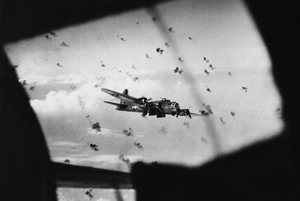 |
A B-17 encounters flak on a raid over Ludwigshafen in 1944. |
The Army Air Forces was the lone champion of daylight precision bombing. The Navy—for whom the Norden bombsight was originally developed—gave up on it in favor of dive bombing. The British, finding that they could not hit precision targets, relied on area bombing at night. Daylight precision bombing was conducted by various kinds of aircraft in World War II, but the real test of it was the long-range strategic bombing missions in Europe and Asia of AAF B-17s, B-24s, and B-29s.
The first experimental bombsights appeared in 1910, but early bombing techniques were rudimentary. Bombing in World War I was at times spectacular—as when Zeppelin airships and Gotha biplanes dropped bombs on London—but it was of little strategic importance. A US Air Service pamphlet in 1918 spoke of bombs hitting “in the vicinity” of the target.
Precision bombing did not come into its own until the 1930s, with the availability of high-quality bombsights from Norden and Sperry and the introduction of faster, longer-ranging bombers. The best Air Corps bombardiers achieved considerable success in good weather and against clearly marked targets, which were typically huge bull’s-eye circles painted on the ground.
Strategic bombardment was not yet an Air Corps mission. Development of long-range bombers had to be justified on the basis of coastal defense. However, the Tactical School theorists did not bother with such pretense. They saw strategic bombardment as the future of warfare. The special mission of the air arm, they said, was to attack the “enemy national structure,” especially the “industrial web,” which was vulnerable to the air arm but not to either of the other arms.
Committed to Precision
Daylight precision bombing became Air Force doctrine, inseparable from the push to obtain four-engine B-17 bombers in appreciable numbers. In 1940, Maj. Gen. Henry H. “Hap” Arnold, Chief of the Air Corps, declared, “The Air Corps is committed to a strategy of high-altitude precision bombing of military objectives.”
The Air Corps regarded the bomber as its principal weapon. Furthermore—on the basis of very thin evidence—the Air Corps concluded that new bombers such as the B-17 and the B-24 flew too high and too fast for pursuit aircraft to catch them and that bombers could operate over enemy territory without fighter escort.
In 1941, the AAF plan to implement Rainbow 5, the basic Army-Navy war plan, was drafted by four officers who had been daylight precision ringleaders at the Tactical School: Lt. Col. Harold L. George, Lt. Col. Kenneth N. Walker, Maj. Haywood S. Hansell Jr., and Maj. Laurence S. Kuter. Air War Plans Division Plan No. 1 (AWPD-1) was straight out of the Maxwell playbook. It prescribed an emphasis on precision bombing against the German national infrastructure, industry—especially the aircraft industry—and the Luftwaffe.
The planners were not misled by pickle barrel assumptions. According to data from training and practice bombing, a heavy bomber at 20,000 feet had a 1.2 percent probability of hitting a 100-foot-square target. About 220 bombers would be required for 90 percent probability of destroying the target. AWPD-1 forecast a need for 251 combat groups to carry out the plan.
Bombing was a complicated proposition. Where the bomb hit was a function of the direction and speed of the airplane at the moment of release, the aerodynamics of the projectile, and the wind and atmospheric conditions while the bomb was in flight.
The bombardier looked through the telescope of the bombsight to find the target somewhere ahead, then made adjustments to compensate for the effects of wind drift and the speed of the airplane. He then fixed the target in the crosshairs, and flew the airplane to the automatically calculated release point by the link from his bombsight to the autopilot.
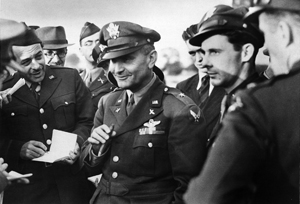 |
Here, Brig. Gen. Ira Eaker speaks with members of the media after the first World War II heavy bomber mission over Europe. |
Historian Stephen L. McFarland has explained the geometry of it, using the example of a B-17 flying at 160 mph at 23,000 feet and dropping a 600-pound bomb. The bomb was released at a distance, measured on the ground, of 8,875 feet from the target. It was in flight for 38 seconds. If the speed calculated for the airplane was off by two mph and the altitude wrong by 25 feet, that made a difference of 115 feet in where the bomb would land.
The limited yield of the bombs added to the problem. A 500-pound bomb, standard for precision missions after 1943, had a lethal radius of only 60 to 90 feet. It dug a crater just two feet deep and nine feet wide. With bombing accuracy measured in hundreds of feet, it took a great many bombs to get the job done.
Such high ratios of ordnance expended to results achieved were not unusual in war, nor were they unique to AAF bombers in World War II. The Army fired 10,000 rounds of small-arms ammunition for each enemy soldier wounded and 50,000 rounds for each enemy killed. It took the Germans an average of 16,000 88 mm flak shells to bring down a single Allied heavy bomber.
Daylight precision bombing got off to a rocky start. When Eighth Air Force was set up in England in 1942, its methods were at odds with those of the Royal Air Force. Air Chief Marshal Arthur T. Harris, chief of Bomber Command, was the foremost advocate of “city busting,” the night area bombing campaign that targeted the German population centers and workforce. He was supported in this by Prime Minister Winston Churchill and a national policy of “dehousing” the Germans.
Churchill wanted the Americans to join the British bombing program rather than instigate a different one of their own. He was prepared to put pressure on President Roosevelt to order the AAF to change its strategy but was talked out of it at the Casablanca Conference in January 1943 by Maj. Gen. Ira C. Eaker, commander of Eighth Air Force. Eaker’s key point was the value of keeping the Germans under attack both day and night.
Eaker had other problems as well. He could not mount large bomber operations because his aircraft and aircrews were diverted to operations in North Africa and the creation of Fifteenth Air Force in Italy in 1943. More than half of his remaining resources were assigned to attacking German submarine pens—a high priority for the British—even though bombing had little effect on these hardened facilities.
Bombing accuracy was terrible. The average circular error in 1943 was 1,200 feet, meaning that only 16 percent of the bombs fell within 1,000 feet of the aiming point. “Rather than dropping bombs into pickle barrels, Eighth Air Force bombardiers were having trouble hitting the broad side of a barn,” said historian McFarland.
The prewar prediction that fighters could not intercept bombers was wrong. The Luftwaffe and ground defenses took a heavy toll on bombers if they ventured without fighter escort deep into hostile territory. As the loss rate spiked to eight percent in early 1943, crews calculated their chances of surviving a 25-mission combat tour. On the Ploesti, Romania, mission in August 1943, losses were 30 percent and against Schweinfurt in October, 28 percent.
The Turning Point
Nobody tackled the accuracy and casualty problems with more initiative than Col. Curtis E. LeMay, commander of the 305th Bomb Group at Grafton-Underwood, Britain. He identified the best bombardiers, made them “lead bombardiers” for the formation, and had all of the aircraft drop their bombs when the lead bombardier did. LeMay also devised a staggered “combat box” formation, which gave the B-17 guns maximum fields of fire for mutual defensive support.
After Schweinfurt, the B-17s did not again fly deep into Germany until long-range P-38 and P-51 fighters were available to escort them. The best of the fighters by far was the P-51, which could escort bombers to their most distant targets. After 1943, all of the fighters, including the older P-47s, took advantage of disposable fuel tanks to extend their range.
Eaker did not have much in the way of strategic bombing results to show for his first two years. However, he said, “When our Eighth Air Force had but 200 bombers operating out of England in 1943, there were more than a million Germans standing at the anti-aircraft and fighter defenses on the West Wall to defend against them. And another million Germans were fire wardens or engaged in bomb damage repair.”
The turning point came in early 1944. By then, Eaker had gone on to be commander in chief of Allied Air Forces in the Mediterranean. Maj. Gen. Jimmy Doolittle replaced him as commander of Eighth Air Force. Several things had changed.
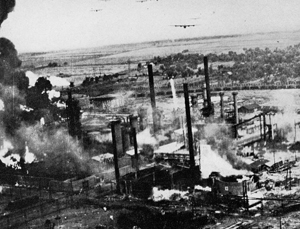 |
A refinery at Ploesti burns as B-24s continue the air assault on Aug. 1, 1943. |
Finally, there were enough bombers to put together large formations. Joint efforts by Eighth and Fifteenth Air Forces put up a 750-bomber mission in January and a 1,000-bomber mission in February. AAF fighters coursed deep into Germany, and in a matter of months, they had virtually destroyed the Luftwaffe. When the D-Day invasion landed in June, the Germans were able to launch less than 100 sorties in defense of Normandy.
With fighter escorts and suppression of enemy air defenses, the aircrew loss rate declined in 1944 and 1945. For the bomber offensive as a whole, Eighth Air Force lost 4,182 aircraft from a total of 273,841 attacking, a rate of 1.5 percent. RAF’s Bomber Command aircraft loss rate for the same period was 2.5 percent. The 250,000 aircrew members who flew bomber missions in Eighth Air Force in World War II sustained 58,000 casualties—18,000 killed, 6,500 wounded, and 33,500 missing.
AAF bombing accuracy improved. By 1945, Eighth Air Force was operating at much lower altitudes and was putting up to 60 percent of its bombs within 1,000 feet of the aiming point, almost four times better than in the dark days of 1943. Radar bombing, adopted from the British, was an alternative when conditions did not permit visual delivery, but it was not a precision technique in any true sense of the word.
RAF Bomber Command continued its night area bombing. From 1942 on, 56 percent of its sorties were against cities. On some occasions, notably the bombing of Dresden in 1945, the AAF joined the British in bombing cities, but overall, less than four percent of US bombs in Europe were aimed at civilians. The main targets for the AAF were marshaling yards (27.4 percent of the bomb tonnage dropped), airfields (11.6 percent), oil installations (9.5 percent), and military installations (8.8 percent).
The US Strategic Bombing Survey found that “Allied airpower was decisive in the war in Western Europe.” That conclusion is sometimes challenged, but the bombing had reduced German rail traffic, aviation fuel production, steel production, and other aspects of the wartime infrastructure by 50 to 90 percent. Millions of people were occupied in repairing the damage and replacing the goods destroyed by bombing. Nazi Armaments Minister Albert Speer said that the bombing created a “third front” and that “without this great drain on our manpower, logistics, and weapons, we might well have knocked Russia out of the war before your invasion of France.”
In the Pacific, the question of daylight precision bombing centered on the last part of the war when the Japanese home islands came within range of the newest and biggest bomber, the B-29. All of the B-29s were assigned to Twentieth Air Force, with Arnold retaining command personally as the agent of the Joint Chiefs of Staff.
Jet Stream Boosts
The B-29 was rushed into operation in June 1944 with XX Bomber Command. The headquarters was in India and the B-29s could reach southern Japan from forward bases in China. LeMay was brought from Europe to head XX Bomber Command.
With the US capture of the Marianas (Saipan, Tinian, and Guam), the B-29s obtained bases from which they could reach almost any target in Japan. XXI Bomber Command was established there, with Hansell, the AWPD-1 planner, now a brigadier general and the most fervent of the daylight precision bombing advocates, in command.
Over Japan, the B-29s encountered the jet stream, fierce winds above 25,000 feet that added as much as 250 mph to an aircraft’s speed relative to the ground. The jet stream pushed the bombers over the target too fast for the Norden bombsight to compensate. Flying against the jet stream, the speed relative to the ground was so slow that the airplanes were sitting ducks.
Daylight precision bombing faltered, especially on the missions from the Marianas. The weather permitted only four days a month of visual bombing. The long distances and high altitudes consumed so much fuel that the bomb loads were relatively small. There were frequent aborts and ditchings as Twentieth Air Force worked the kinks out of the new bomber under combat conditions.
Arnold and the AAF were under tremendous pressure to produce strategic results and help bring the war in the Pacific to an end. Hansell stuck doggedly to daylight precision bombing, although repeated efforts against such targets as the Nakajima-Musashino aircraft plant near Tokyo were unsuccessful.
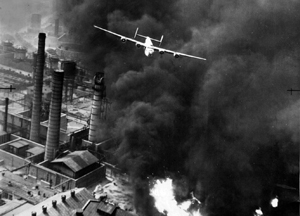 |
A Liberator on the same day skirts a towering column of smoke.
|
Meanwhile, the clamor was building in Washington to switch to incendiary area bombing. The Office of Scientific Research and Development had developed the highly effective M-69 incendiary bomb, to which the Japanese style of construction was starkly vulnerable. Japanese industry, including cottage industries making military parts and equipment, was so integrated with populated areas that it was difficult to draw the line between them.
The Japanese regarded surrender as dishonorable and fought to the last in battle after battle. The possibility loomed that an invasion of the Japanese home islands would be necessary. Plans projected a landing force of 1.8 million US troops and anticipated massive casualties. The US was no longer as reluctant as it once had been to bomb enemy cities.
LeMay, who was the more aggressive commander and who had gotten better results with the B-29s in India and China, replaced Hansell at XXI Bomber Command in January 1945. XX Bomber Command was phased out and its aircraft and crews were transferred to the Marianas.
It had become apparent, LeMay said, that “we weren’t going to be able to defeat Japan using high-altitude precision bombing before the scheduled invasion was to begin.”
Acting on his own initiative, LeMay ordered a massive low-level night mission against Tokyo with incendiary bombs March 9. Three wings of bombers would attack from the altitudes of 4,000 to 9,200 feet. The aircraft were stripped of excess weight, including most of the guns. Flying lower and less heavily laden, the B-29s carried more than twice as many bombs as before. The strike force found landfall by radar and bombed with intervalometers set to space the bombs 50 feet apart. About a fourth of Tokyo was destroyed and some 84,000 people were killed. It was supposedly while touring the firebombed area that Emperor Hirohito came to the conclusion that the war had to end as soon as possible.
LeMay continued to order precision attacks and to use high explosive bombs when targets and weather were suitable, but the emphasis had shifted to incendiary bombing at night. It systematically laid waste to Japan’s large industrial cities and by July, had reduced overall Japanese industrial output to some 60 percent from the 1944 level.
LeMay and Arnold believed that the incendiary bombing would eventually bring on a Japanese surrender. Gen. George C. Marshall, the Army Chief of Staff, and President Truman were not convinced. The Japanese military hardliners were prepared to accept enormous casualties and destruction and had assembled a force of 2.3 million troops in the home islands to throw back an invasion. Truman decided to use the atomic bomb.
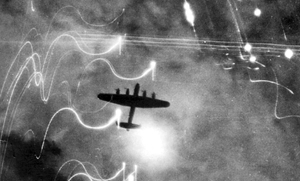 |
RAF Lancasters—such as this one on a bombing raid over Hamburg—were primarily used as nighttime bombers, but also excelled at daylight precision bombing. |
Infrastructure Devastation
Both at Hiroshima Aug. 6 and at Nagasaki Aug. 9, the atomic bombs were delivered by daylight high-altitude precision drop, using the Norden bombsight. Maj. Thomas W. Ferebee, bombardier on the B-29 Enola Gay, picked up the aiming point in Hiroshima, the Aioi Bridge, 12 miles out. The bomb, dropped from 30,700 feet, detonated in an airburst 800 feet (measured on the ground) from the bridge. The bombardier for Nagasaki was Capt. Kermit K. Beahan on the B-29 Bockscar. The bombing altitude was 31,000 feet and the explosion was 1,500 feet from the aiming point, the Mitsubishi Steel and Arms Works.
The hardliners wanted to hold out, but Emperor Hirohito broadcast his rescript of surrender Aug. 15, bringing World War II to a close.
Postwar analysis found that accuracy had been about the same in Europe and Asia for day visual and radar precision bombing. Eighth Air Force in Great Britain put 31.8 percent of its bombs within 1,000 feet of the aim point from an average altitude of 21,000 feet. Fifteenth Air Force in Italy averaged 30.78 percent of its bombs within 1,000 feet from 20,500 feet. In the Asia and the Pacific, Twentieth Air Force—45.5 percent of whose sorties were daylight precision despite the emphasis on area bombing in the last months of the war—put 31 percent of its bombs within 1,000 feet of the aim point, although the bombing altitudes were on average 4,500 feet lower than for Eighth Air Force.
Critics of various persuasions have challenged the value of the strategic bombing. However, postwar occupation authorities found that both the German and Japanese economies and their national infrastructures had been devastated to the point that they barely functioned. Industries that had supported the war were in shambles. That level of destruction and disruption was the result of Allied land, sea, and air action—and airpower had hardly been the least of it.
After the war, “pickle barrel” claims passed out of fashion even though nostalgic bombardiers and the popular press kept the notion alive for years. Despite the advent of nuclear weapons, the quest for precision delivery of bombs continued. The first Strategic Air Command Bombing Competition was held in 1948 at Castle AFB, Calif., with visual and radar releases from 25,000 feet. SAC continued to develop radar bombing techniques and used them effectively in its Arc Light missions in Vietnam.
Precision guided munitions first gained fame in the Vietnam War, but it was in the Gulf War and other conflicts of the 1990s that the Air Force finally achieved pickle barrel accuracy, placing bombs within 10 feet of the aim point. The use of the Global Positioning System and satellite data for aiming had made the issue of day vs. night irrelevant.
| The Mystique of the Norden Bombsight
Other companies made bombsights, but the famous name was Norden. Carl L. Norden was a Dutch engineer who immigrated to the United States in 1904 and worked for Sperry Gyroscope before going into business for himself. He lived in the United States for 43 years but never became a citizen.
Norden began his contract work with the US Navy in 1918. He liked the Navy better than the Air Corps, which he considered too flamboyant. He preferred the Navy as a customer, even though the Navy moved away from high-altitude horizontal bombing in the 1930s and took the bombsights out of most of its airplanes in the 1940s. (For no better reason than service parochialism, the Navy held on to its Norden bombsights, which it was not going to use, even though the AAF had a critical need for them.) Some commanders were said to have required a “bombardier’s oath” from their young men. Wording of the oath varied from report to report, but all included the vow to protect the secrecy of the Norden bombsight “if need be, with my life itself.” Actually, the secret had been blown, several times over. A Norden employee sold drawings to the Germans in 1938. The Russians stole a bombsight in 1940 but could not figure it out. They gave it to their (then) allies, the Germans. The Germans soon had plenty of samples of their own from the wreckage of US bombers shot down. In 1944, the US gave the Russians 100 lend-lease patrol aircraft—complete with Norden bombsights and a training package—in return for allowing US shuttle bombers to land in Soviet-controlled territory. |
John T. Correll was editor in chief of Air Force Magazine for 18 years and is now a contributing editor. His most recent article, “GHQ Air Force,” appeared in the September issue.